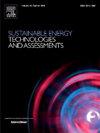Revolutionizing drying chambers for sustainable energy technologies in food and agriculture: A comprehensive review
IF 7.1
2区 工程技术
Q1 ENERGY & FUELS
Sustainable Energy Technologies and Assessments
Pub Date : 2025-01-27
DOI:10.1016/j.seta.2025.104205
引用次数: 0
Abstract
Energy efficiency and food security could be substantially improved by advancing and implementing drying chambers in diverse drying technologies. The drying chamber is critical for producing high-quality dried food and agricultural products while also ensuring excellent drying system performance. It has received much attention recently due to its primary effect on drying technologies. This research examines the drying chamber system in diverse drying technologies, using current literature to highlight significant shortcomings for future work on this subject and to demonstrate potential improvement techniques. Furthermore, the paper summarizes the examination of temperature and airflow distribution systems and different drying methods based on various heat transfer mechanisms. A thorough review of multiple previous research findings is also provided, and the limitations and prospects for its future use in drying are highlighted. In addition, further improvement strategies are recommended, including enhancing the heat source, optimizing the environmental conditions around the drying chamber, introducing jet impingement technology, establishing an advanced monitoring system, and adding a directed nozzle. Hybrid drying has been known as a viable approach for improving drying efficiency and uniformity. However, further research is required to minimize costs while improving such components’ effectiveness and technical design.
求助全文
约1分钟内获得全文
求助全文
来源期刊

Sustainable Energy Technologies and Assessments
Energy-Renewable Energy, Sustainability and the Environment
CiteScore
12.70
自引率
12.50%
发文量
1091
期刊介绍:
Encouraging a transition to a sustainable energy future is imperative for our world. Technologies that enable this shift in various sectors like transportation, heating, and power systems are of utmost importance. Sustainable Energy Technologies and Assessments welcomes papers focusing on a range of aspects and levels of technological advancements in energy generation and utilization. The aim is to reduce the negative environmental impact associated with energy production and consumption, spanning from laboratory experiments to real-world applications in the commercial sector.
 求助内容:
求助内容: 应助结果提醒方式:
应助结果提醒方式:


